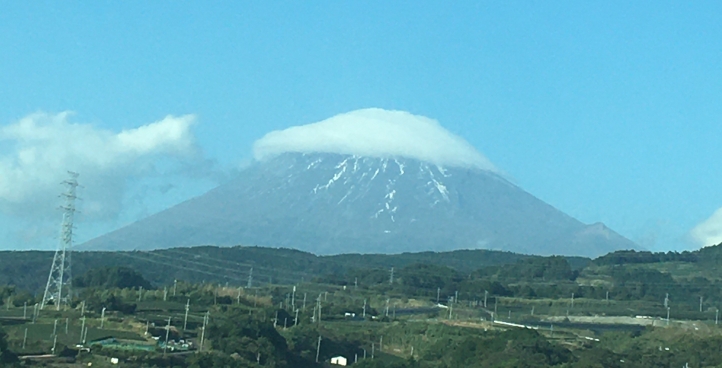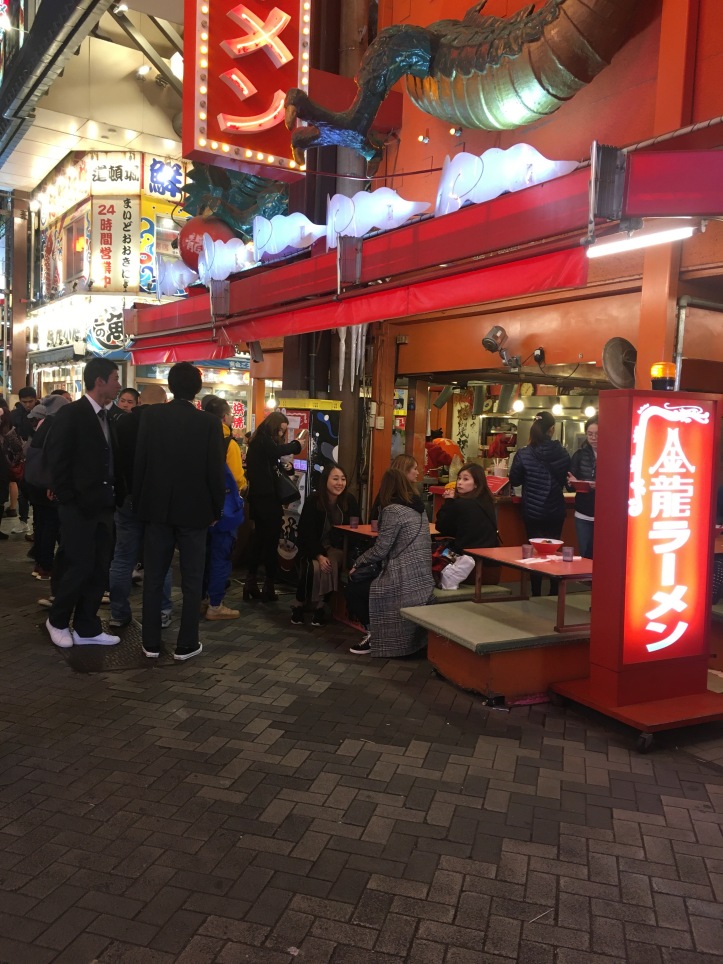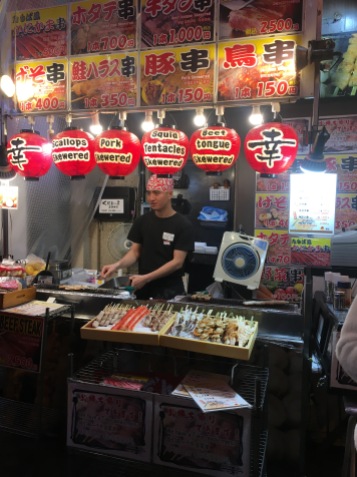Continued from my last post The Imperial Palace Tokyo
After an early breakfast at the Dean and Deluca coffee shop we set out from our hotel the Oakwood Aoyama. We took a taxi to Tokyo station for a short but expensive ride of five km which set us back by 3300 yen. At a prominently marked counter we  exchanged our voucher for a seven day JR pass and made our reservation on the next available Shinkansen to Shin Osaka ( See my post JR Pass or not? ). The investment in a JR pass was a smart one as it proved to save us costs and offered us great flexibility and convenience. Once we had our exchanged JR pass in hand we made our way to the tracks to board the Shinkansen to Shin Osaka. The signs were very easy to follow and they led us right to our coach and seat. On our way to Osaka we sat on the left side of the train and we did not get a good view of the Mount Fuji from our seats. Always choose seats on the Fujiyama side of the rain. You get to see the mountain for quite some distance along the way though the best views are around Odawara station. From long shots to panoramic to closeups the mountain provides numerous photo ops .
exchanged our voucher for a seven day JR pass and made our reservation on the next available Shinkansen to Shin Osaka ( See my post JR Pass or not? ). The investment in a JR pass was a smart one as it proved to save us costs and offered us great flexibility and convenience. Once we had our exchanged JR pass in hand we made our way to the tracks to board the Shinkansen to Shin Osaka. The signs were very easy to follow and they led us right to our coach and seat. On our way to Osaka we sat on the left side of the train and we did not get a good view of the Mount Fuji from our seats. Always choose seats on the Fujiyama side of the rain. You get to see the mountain for quite some distance along the way though the best views are around Odawara station. From long shots to panoramic to closeups the mountain provides numerous photo ops .

It was a delight to travel on the Shinkansen or the bullet train which has been in existence since 1964 . They travel at speeds around 300 km per hour and are constantly being upgraded. As per the latest information  from JR the new test Maglev trains have established a land speed record of 615 km per hour in 2015. As a comparison India’s fastest train is the Vande Bharat express which touches 160 km per hour and does not qualify as a high speed train. The average delay of a Shinkansen trains has been stated to be 24 seconds in spite of accounting for natural disasters! Just simply cannot imagine the efficiency. Safety statistics are of a similar order. These speeds enabled a same day return from Kyoto which had given a great boost to business travelers and in turn the Japanese economy. And of course for tourists too.
from JR the new test Maglev trains have established a land speed record of 615 km per hour in 2015. As a comparison India’s fastest train is the Vande Bharat express which touches 160 km per hour and does not qualify as a high speed train. The average delay of a Shinkansen trains has been stated to be 24 seconds in spite of accounting for natural disasters! Just simply cannot imagine the efficiency. Safety statistics are of a similar order. These speeds enabled a same day return from Kyoto which had given a great boost to business travelers and in turn the Japanese economy. And of course for tourists too.
One of the features of the Shinkansen that caught my attention was the amazingly high levels of cleanliness on the train including the toilets. All spotlessly clean- an d it is not as if there is an army of cleaners on the job all the time. It is the innate discipline of the Japanese who keep the surroundings clean. In fact you would even Youtube a tutorial on the hi tech(!) toilets on the bullet train. Seats were extremely comfortable with ample space for luggage. An onboard snack service adds to the experience. Our Suica cards came in handy here as well. And of course there are a few smoking rooms spread across the train. The smoker in me simply loved that and the thought that somebody cares for us ostracised smoker types warmed my heart. And all this on a two and half hour journey to Kyoto. Add another 15-20 minutes to Shin Osaka.
d it is not as if there is an army of cleaners on the job all the time. It is the innate discipline of the Japanese who keep the surroundings clean. In fact you would even Youtube a tutorial on the hi tech(!) toilets on the bullet train. Seats were extremely comfortable with ample space for luggage. An onboard snack service adds to the experience. Our Suica cards came in handy here as well. And of course there are a few smoking rooms spread across the train. The smoker in me simply loved that and the thought that somebody cares for us ostracised smoker types warmed my heart. And all this on a two and half hour journey to Kyoto. Add another 15-20 minutes to Shin Osaka.
From Shin Osaka station we found our way easily to the next door Marriott Hotel. A delayed check in and were off for a late lunch to Shin Osaka station which was to be our food station for the next couple of days. From the station we took a taxi to Dotonbori, the entertainment district of Osaka. It was a rather cold day but the streets were teeming with people; both local and tourists. The main attraction is the Dotonbori canal and provides an interesting option to spend the evening quietly amidst the surrounding hustle and bustle.The streets are dotted with all kinds of retails shops varying in size from a small hole in the wall to large department stores all very brightly lit.  Also seen are some interesting bill boards outside restaurants. Along side is a picture of the mechanical crab outside a crab restaurant KAni Doraku. Most of the construction is of recent origin though the market traces its history back to the 1600s till it was finally destroyed by the bombing raids of the Second World War. Whether it was the Sensoji temple or the Imperial Palace in Tokyo or in this case the Dotonbori one cannot but admire the resilience of the Japanese who have come out of the enormous destruction of the world war with a stronger will to survive and excel in all that they would do. We were to see more of this spirit in our journey to Hiroshima a few days later.
Also seen are some interesting bill boards outside restaurants. Along side is a picture of the mechanical crab outside a crab restaurant KAni Doraku. Most of the construction is of recent origin though the market traces its history back to the 1600s till it was finally destroyed by the bombing raids of the Second World War. Whether it was the Sensoji temple or the Imperial Palace in Tokyo or in this case the Dotonbori one cannot but admire the resilience of the Japanese who have come out of the enormous destruction of the world war with a stronger will to survive and excel in all that they would do. We were to see more of this spirit in our journey to Hiroshima a few days later.
Dotonbori is great place to sample the delights of Japanese cuisine. We rested our legs on a bench for a while along the Dotonbori canal listening to loud Japanese and western music before we set out for dinner. Giant and brightly lit up hoardings and signage invite passersby to sample the wares on offer.  We started with a orange juice served to us in the fruit itself, followed it up with some roasted chestnuts and rounded it off with an Indian meal at Mithila. We were content with looking at the various street food stalls and resolved to return the next day to sample the traditional Japanese offerings – Okonomiyaki and Ramen and also meet the mechanical crab but sadly that was not to be.
We started with a orange juice served to us in the fruit itself, followed it up with some roasted chestnuts and rounded it off with an Indian meal at Mithila. We were content with looking at the various street food stalls and resolved to return the next day to sample the traditional Japanese offerings – Okonomiyaki and Ramen and also meet the mechanical crab but sadly that was not to be.
Here we came across the much spoken about Japanese culture of going out of the way to help a passerby with directions. We asked the lady at the restaurant for directions to the station and she insisted that she walk us all the way to Namba station, a good few hundred yards away and deposited us at the entrance. We were joking that had we asked for more directions she would take us home as well. Such helpful nature will be viewed with alarm and concern in many parts of the world!



